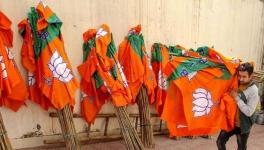Bengal: Thousands of Mahua Flower, Fruit Collecting Families Face Neglect in JangalMahal

Mahua flowers being collected by women at Bhalukgenja village in Bankura, to be distributed equally among all the women. Image credit: Madhu Sudan Chatterjee
In the Jangal Mahal areas of Bengal, the prevailing temperature ranges between 42-45 degrees Celsius. Due to this extreme heat, people refrain from venturing outdoors unless absolutely necessary. However, for a weary traveller seeking respite, stopping under the shade of a thick-leaved tree offers not only relief but also a sweet, intoxicating essence that permeates the air.
This delightful aroma emanates from the Mahua flowers, locally known as Mahulful, which blooms on ancient Mahua trees that have stood for decades in the region. These trees have been a vital source of sustenance for thousands of people in Bankura, Purulia, and Jhargram districts, particularly those from economically and socially marginalised backgrounds. At present, about 10,000 families in these three districts are trying hard to make a living around mahua trees. But how long will this continue?
A decade ago, during the tenure of the Left Front government, the government-operated Large-scale Adivasi Multipurpose Society (LAMS) collaborated closely with the local communities reliant on forest resources. The majority of these collectors, who gather Mahua flowers and fruits, were women from economically disadvantaged backgrounds.

Mahua flowers being collected by women at Bhalukgenja village in Bankura, to be distributed equally among all the women.
LAMS served as a trustworthy cooperative, purchasing all Mahua flowers and fruits at fair prices, thereby supporting the livelihoods of these collectors. However, since the change in government in Bengal in 2011, this cooperative has become virtually inactive, leaving the flower collectors without a reliable means of support.
In the last parliamentary election, both the Bharatiya Janata Party (BJP) and the Trinamool Congress (TMC), ruling at the Centre and the state, respectively, made promises to assist those involved in collecting forest resources. However, residents allege that after the election, neither the central nor state ruling parties fulfilled these promises.
Despite all Members of Parliament (MPs) from the Jangal Mahal areas belonging to BJP, including Subash Sarkar, MP from Bankura, who also serves as the Minister of State for Education in the Union government, and TMC, such as Jyotsna Mandi, minister of state for food in the West Bengal government from the Ranibandh Assembly constituency, none has come forward to support the forest resource-dependent communities or honour their promises.
How do people collect and sell Mahua flowers and fruits?
"At dawn, we leave our homes with baskets in hand. The Mahulgachher jungle (Mahua tree forest) lies within our village, a short distance from the residential area. It takes approximately 10 minutes to reach there. The previous evening, we observed Mahua flowers beginning to bloom on the trees. These flowers bloom throughout the night, falling to the ground as soon as the sun rises, continuing until late afternoon. We go and collect those," Chunu Mal and Namita Mal, residents of Bhalukgenja village, while picking flowers, told this writer.

Mahua flowers being dried in the sun at Chalkigora under Barikur gram panchayat, Ranibandh Block, Bankura.
This remote village is situated near the Sunukpahari market, under Bankura 1 Block, approximately 20 kilometers from the district headquarters of Bankura. Notably, the majority of the population here belongs to the Scheduled Caste, with fifty-four families involved in the collection of Mahua flowers and fruits.
During the summer and spring seasons in the dry tropical forests of Bengal, a particular tree blooms – the Mahua tree. Its flowers, fruits, and leaves fill the forest with an irresistible scent that attracts humans and animals alike. With its alcoholic properties, the flowers of this tree are also known to intoxicate wild boars and elephants. The Mahua tree is an ancient species, mentioned in Sanskrit texts dating as far back as 2nd century BC. Such is the allure of the Mahua, India's most intoxicating and sacred tree.
Not confined to the Jangal Mahal area alone, the Mahua tree is found across the states of Bengal, Odisha, Chhattisgarh, Jharkhand, Bihar, Uttar Pradesh, Gujarat, Madhya Pradesh, Telangana, Maharashtra, Kerala, and Tamil Nadu. It typically grows to a height of 15-20 meters, with a trunk diameter of around 80 cm. Its flowers are yellow, and its fruits are green.
Mahua fruit, locally called Kochra
Mahua flowers begin to bloom from mid-April, lasting only one night before falling to the ground. It takes approximately 15 days for these flowers to produce usable fruit, which is green in colour, locally known as Kochrafal. People consume these fruits as a vegetable. Each fruit contains four seeds, which are used to produce cooking oil, soap, and fertiliser.
Furthermore, expensive wine is made from Mahua flowers, and these are also boiled with rice powder to make a cake locally known as 'molpithe.' This cake is not only delicious but also high in calories and nutritional value, serving as a good source of Vitamin A and C. Historical records indicate that during the famine in undivided Bengal in 1770, Mahua trees saved thousands of families from starvation. These trees have a long lifespan, lasting for hundreds of years, and do not require replanting, as they naturally regenerate and grow.
The people of the Jangal Mahal areas have been involved in the collection of Mahua flowers and fruits for generations. More than just economic transactions, this activity is deeply rooted in the cultural heritage of the region. Numerous tribal and non-tribal folk artistes have written songs, poems, stories, and novels inspired by Mahua, which are often performed alongside traditional dances.
“For the people of Jangal Mahal, Mahua holds significant emotional value," Mohan Hembram, a folk artiste from Barikul Ranibandh, Bankura, and Tapan Mahato from Lodhasuli, under Jhargram district, said.
Manorath Mahato, a young folk artiste and social worker from Manbazar 2 Block, Purulia district, emphasised the importance of recognising and supporting those involved in the risky task of collecting Mahua flowers and fruits.
An old woman drying Mahua flowers in the sun at Banspahari area of Jhargram district.
Belarani Mahato and Jhulu Mahato of Beladihi village under Barijagda gram panchayat, along with others, highlighted the challenges they face, particularly since the functioning of the LAMS has practically ceased. They lamented that outside traders offer low prices, forcing them to sell at rates as low as Rs 20 a kilogram.
Similar sentiments were echoed by Mithu Sardar, Jhuma Hansda, and Purnima Murmu from Banspahari area of Jhargram district, who recounted the dangers they encountered, including wild elephant attacks, while collecting flowers. Despite these hardships, traders from Kolkata purchase dry Mahua flowers at Rs 20/kg, which are then used to produce expensive wine, some of which is exported to Indonesia.
Women Set an Example
In spite of the challenging financial situation, the women of Bhalukgenja village in Bankura 1 Block have collectively set an example in their work. All the women of the village work diligently, each earning equally. Kabita Mal, Anima Mal, and Jhuma Mal, told this reporter about their routine a few days ago, while collecting Mahua in 44-degree temperature.
The women said they leave their homes at dawn to collect flowers in the forest. “We determine the time by observing the shadow of the trees. Once we've collected, we bring our flowers to a designated spot by 11 o’clock. From there, we divide the flowers, ensuring that everyone receives an equal share. We do not distinguish between those who collect more or less; everyone returns home with an equal portion.”
“Furthermore, if someone is unable to come due to illness, we deliver the specific quantity of flowers owed to their home,” said Anima Mal with a smile. She said that this decision was made out of necessity to ensure fair treatment and equal earnings for all. She added that not only housewives, even younger girls, who are now studying in schools and college, also participate in collecting Mahua flowers. This reporter saw college students Puja, Tumpa and others like going to the forest to collect the flowers.
Mahua flowers being collected by women at Bhalukgenja village in Bankura, to be distributed equally among all the women.
After picking, Mahua flowers are sun-dried for about a month until they turn brown and shrink to the size of raisins. They are then sold to outside traders at Rs 20/kg. A woman typically collects flowers throughout April, and after drying, her yield reaches up to two quintals, at most. If the yield is excessive in one season, a family can earn a maximum of Rs 4,000 from Mahua flowers.
Some of the flowers are kept at home for consumption. The taste of this flower is sweet, and it is often consumed by cooking Molpithe. This cake takes a long time to digest, making it a preferred meal before going out to work, as mentioned by farm labourer Madhuri Mal.
Mahua fruits are harvested one month after flower collection. These fruits, locally known as Kochra, are used as a vegetable and sold in the market for Rs 30/kg. Traders also purchase these fruits at the rate of Rs 15/kg. The seeds from these fruits are used to produce oil, which is used as cooking oil in some parts of the Jangal Mahal area.
The government knows that a businessman earns crores of rupees by making excellent quality wine from Mahua flowers. But those who collect these flowers in the midst of intense heat, dry them to give them to traders at a negligible price – all for measly amounts.
Is the government even aware about the hardships of these marginalised poor people? Will there be no ‘acche din’ or good days in their lives? Will the government announce a fair price and stand by these flower collectors? These are some questions that mahua flower and fruit collecting mothers and sisters of Bengal’s Jangal Mahal have raised.
When asked whether the state government had taken any decision to stand by the mahua flower and fruits collectors by reviving LAMS, the Additional District Magistrate ( General) of Bankura district, Nakul Chandra Mahato, said that the administration had no intention of taking any such initiative as of now.
The writer covers the Jangal Mahal region for Bengali daily ‘Ganashakti’ in West Bengal.
Image credit: Madhu Sudan Chatterjee
Get the latest reports & analysis with people's perspective on Protests, movements & deep analytical videos, discussions of the current affairs in your Telegram app. Subscribe to NewsClick's Telegram channel & get Real-Time updates on stories, as they get published on our website.
























